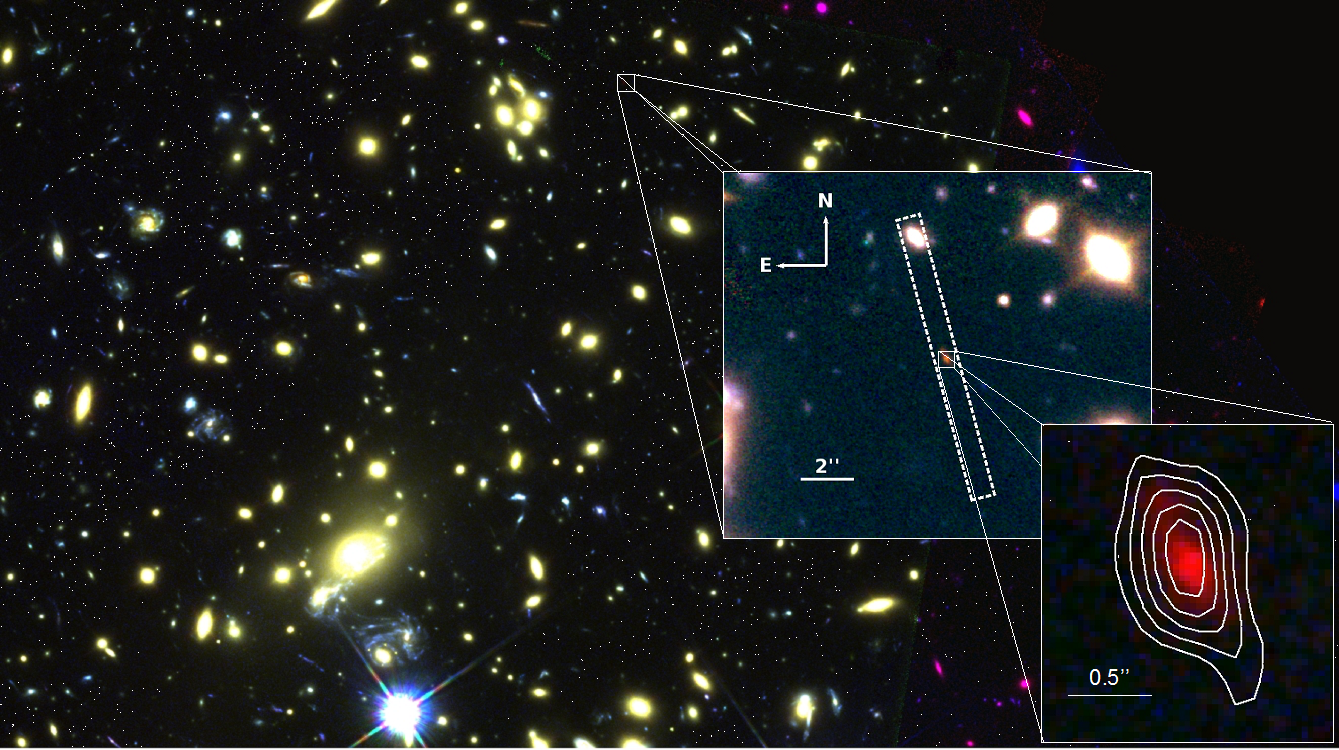Stars Formed Only 250 Million Years After the Big Bang, a Step Closer to Cosmic Dawn
Stars in a galaxy 13.28 billion light-years away formed just 250 million years after the Big Bang.
In a galaxy far, far away — a galaxy called MACS1149-JD1 — stars formed earlier in the universe's history than scientists can directly detect, according to new observations. Additionally, the same research revealed that MACS1149-JD1 is the most distant known source of oxygen and the most distant galaxy with a precise distance measurement, study co-author Nicolas Laporte, a researcher at University College London (UCL), told Space.com.
MACS1149-JD1 was first discovered in 2012 as one of the farthest objects from Earth whose light scientists can observe. Now, the research team, led by groups at UCL and Osaka Sangyo University in Japan, has taken a precise measurement of the galaxy's redshift — when the wavelength of light is stretched, the light looks "shifted" to the red end of the spectrum. A redshift measurement can tell us how far away the object emitting light (the galaxy, in this case) is, and, based on how fast the universe is expanding, when the light was emitted. [From the Big Bang to Now in 10 Easy Steps]

In identifying oxygen, the age of the stars in this galaxy was made apparent. Oxygen is created in stars and released into the gas clouds in the galaxy when those stars die — so confirming the presence of oxygen in MACS1149-JD1 showed how an older generation of stars had already existed and died within the system. Although the researchers weren't shocked to find oxygen, they were surprised at how early in the universe's history this oxygen formed, so they had to investigate further and compute the age of the stars, Laporte said. [How the Huge ALMA Radio Telescope Works (Infographic)]
Using the Atacama Large Millimeter/Submillimeter Array (ALMA) in Chile, the team measured the properties of an emission line of doubly ionized oxygen in MACS1149-JD1's spectrum, which revealed that the galaxy's redshift is about 9.11. Larger redshift measurements correspond with fainter, more distant galaxies, and so this measurement led the researchers to conclude that they were viewing the galaxy at about 550 million years old, according to a UCL statement about the new work.
By studying infrared data from the NASA/ESA Hubble Space Telescope and the NASA Spitzer Space Telescope, the research team observed the brightness of the galaxy. This observation suggested that there was substantial star formation in this galaxy just 250 million years after the Big Bang, according to the statement. The redshift measurement taken by ALMA allowed the team to rule out other explanations for this observation, like the possibility that the observed brightness arose from strong recombination lines — or features of the spectrum associated with radiation produced by hot stars, solidifying the team's conclusion.
The team confirmed the distance of the galaxy through these observations from ALMA and the European Southern Observatory's (ESO) Very Large Telescope (VLT).
Breaking space news, the latest updates on rocket launches, skywatching events and more!
In future studies, researchers could use even more sensitive measurements to view the first stars and galaxies in the universe, Laporte said.
"If you want to go back, back in time, [you could] push back the observation of galaxies and stars up to very high redshift, 20, 50," he said. By finding the point in the universe's history where stars and galaxies first formed — an epoch known as cosmic dawn — scientists would answer one of the biggest mysteries in modern astronomy. Did the first galaxies emerge from a completely dark universe? What were these first stars and galaxies like? This research could be a step forward in answering these monumental questions, Laporte said.
This new observation, while a groundbreaking measurement of a distant system, is "just one data point in one galaxy," Rychard Bouwens, a researcher who is not involved in the study and who discussed this recent work in a News & Views piece in Nature, told Space.com. But, while MACS1149-JD1 is just "a glimpse," as Bouwens said, toward cosmic dawn, Bouwens also discussed how the eagle-eyed James Webb Space Telescope will take this work even further. "With the planned James Webb Space Telescope," he said, we "will be able to observe many of these systems and be able to make the observations more directly."
So, while this new work takes us far back into the universe's history, advancing telescope technology like the highly anticipated launch in the next few years of the Webb telescope will be able to get even closer to cosmic dawn, as Bouwens discussed.
This work is detailed today (May 16) in the journal Nature.
Email Chelsea Gohd at cgohd@space.com or follow her @chelsea_gohd. Follow us @Spacedotcom, Facebook and Google+. Original article on Space.com.
Join our Space Forums to keep talking space on the latest missions, night sky and more! And if you have a news tip, correction or comment, let us know at: community@space.com.

Chelsea “Foxanne” Gohd joined Space.com in 2018 and is now a Senior Writer, writing about everything from climate change to planetary science and human spaceflight in both articles and on-camera in videos. With a degree in Public Health and biological sciences, Chelsea has written and worked for institutions including the American Museum of Natural History, Scientific American, Discover Magazine Blog, Astronomy Magazine and Live Science. When not writing, editing or filming something space-y, Chelsea "Foxanne" Gohd is writing music and performing as Foxanne, even launching a song to space in 2021 with Inspiration4. You can follow her on Twitter @chelsea_gohd and @foxannemusic.
